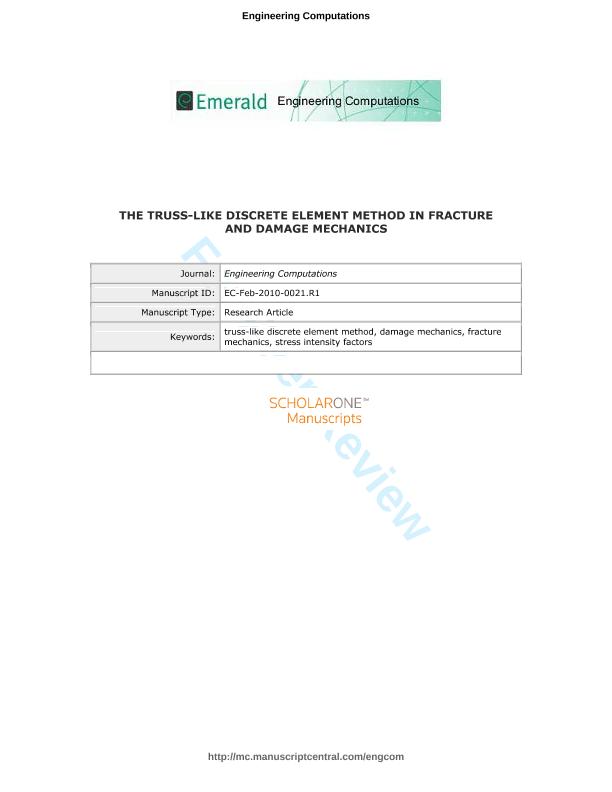Mostrar el registro sencillo del ítem
dc.contributor.author
Kosteski, Luis
dc.contributor.author
Iturrioz, Ignacio
dc.contributor.author
Batista, Ruben Galiano
dc.contributor.author
Cisilino, Adrian Pablo

dc.date.available
2016-12-27T17:46:10Z
dc.date.issued
2011-12
dc.identifier.citation
Kosteski, Luis; Iturrioz, Ignacio; Batista, Ruben Galiano; Cisilino, Adrian Pablo; The truss‐like discrete element method in fracture and damage mechanics; Emerald Group Publishing Limited; Engineering Computations; 28; 6; 12-2011; 765-787
dc.identifier.issn
0264-4401
dc.identifier.uri
http://hdl.handle.net/11336/10309
dc.description.abstract
Purpose: It is the purpose of this paper to further develop the truss-like discrete element method (DEM) in order to make it suitable to deal with damage and fracture problems. Design/methodology/approach: Finite and boundary elements are the best developed methods in the field of numerical fracture and damage mechanics. However, these methods are based on a continuum approach, and thus, the modelling of crack nucleation and propagation could be sometimes a cumbersome task. Besides, discrete methods possess the natural ability to introduce discontinuities in a very direct and intuitive way by simply breaking the link between their discrete components. Within this context, the present work extends the capabilities of a truss-like DEM via the introduction of three novel features: a tri-linear elasto-plastic constitutive law; a methodology for crack discretization and the computation of stress intensity factors; and a methodology for the computation of the stress field components from the unixial discrete-element results. Findings: Obtained results show the suitability and the performance of the proposed methodologies to solve static and dynamic crack problems (including crack propagation) in brittle and elasto-plastic materials. Computed results are in good agreement with experimental and numerical results reported in the bibliography. Originality/value: The scope of the truss-like DEM has been extended. New procedures have been introduced to deal with elastoplastic crack problems and to improve the post processing of the stress results. Research implications: This paper demonstrates the versatility of the truss-like DEM to deal with damage mechanics problems. The approach used in this work can be extended to the implementation of time dependent damage mechanisms. Besides, the capabilities of the discrete approach could be exploited by coupling the truss-like DEM to finite and boundary element methods. Coupling strategies would allow using the DEM to model the regions of the problem where crack nucleation and propagation occurs, while finite or boundary elements are used to model the undamaged regions.
dc.format
application/pdf
dc.language.iso
eng
dc.publisher
Emerald Group Publishing Limited

dc.rights
info:eu-repo/semantics/openAccess
dc.rights.uri
https://creativecommons.org/licenses/by-nc-sa/2.5/ar/
dc.subject
Discrete Element Method
dc.subject
Fracture Mechanics
dc.subject
Damage Mechanics
dc.subject
Truss‐Like Discrete Element Method
dc.subject
Stress Intensity Factors
dc.subject
Elastoplastic Analysis
dc.subject
Numerical Analysis
dc.subject.classification
Mecánica Aplicada

dc.subject.classification
Ingeniería Mecánica

dc.subject.classification
INGENIERÍAS Y TECNOLOGÍAS

dc.subject.classification
Ingeniería de los Materiales

dc.subject.classification
Ingeniería de los Materiales

dc.subject.classification
INGENIERÍAS Y TECNOLOGÍAS

dc.title
The truss‐like discrete element method in fracture and damage mechanics
dc.type
info:eu-repo/semantics/article
dc.type
info:ar-repo/semantics/artículo
dc.type
info:eu-repo/semantics/publishedVersion
dc.date.updated
2016-10-26T21:18:47Z
dc.journal.volume
28
dc.journal.number
6
dc.journal.pagination
765-787
dc.journal.pais
Reino Unido

dc.journal.ciudad
West Yorkshire
dc.description.fil
Fil: Kosteski, Luis. Universidade Federal do Rio Grande do Sul; Brasil
dc.description.fil
Fil: Iturrioz, Ignacio. Universidade Federal do Rio Grande do Sul; Brasil
dc.description.fil
Fil: Batista, Ruben Galiano. Universidade Federal do Rio Grande do Sul; Brasil
dc.description.fil
Fil: Cisilino, Adrian Pablo. Consejo Nacional de Investigaciones Científicas y Técnicas. Centro Científico Tecnológico Mar del Plata. Instituto de Investigación en Ciencia y Tecnología de Materiales (i); Argentina. Universidad Nacional de Mar del Plata. Facultad de Ingeniería; Argentina
dc.journal.title
Engineering Computations

dc.relation.alternativeid
info:eu-repo/semantics/altIdentifier/doi/http://dx.doi.org/10.1108/02644401111154664
dc.relation.alternativeid
info:eu-repo/semantics/altIdentifier/url/http://www.emeraldinsight.com/doi/abs/10.1108/02644401111154664
Archivos asociados
